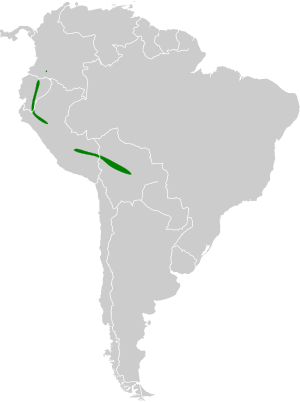Many-spotted hummingbird facts for kids
The many-spotted hummingbird (Taphrospilus hypostictus) is a beautiful type of hummingbird. It's known for the many green spots on its white belly. This tiny bird lives in the forests of South America. You can find it in countries like Bolivia, Colombia, Ecuador, and Peru. It might even live in Argentina too!
Quick facts for kids Many-spotted hummingbird |
|
|---|---|
 |
|
| Conservation status | |
| Scientific classification | |
| Genus: |
Taphrospilus
|
| Species: |
hypostictus
|
 |
|
| Range map | |
| Synonyms | |
|
Talaphorus hypostictus, Leucippus hypostictus |
|
Contents
About the Many-Spotted Hummingbird
This special hummingbird is the only species in its group, called Taphrospilus. This means it's quite unique! Scientists sometimes discuss if it belongs to other similar groups. But for now, it stands alone.
What Does the Many-Spotted Hummingbird Look Like?
The many-spotted hummingbird is a small bird. It grows to be about 10.5 to 11.4 centimeters (4 to 4.5 inches) long. It weighs around 6.7 to 9 grams (0.2 to 0.3 ounces). Both male and female birds look very much alike.
They have a slightly curved black beak, about 2.3 cm (0.9 in) long. Their backs are a pretty grass green or coppery bronze color. Their bellies are white, but they are covered in thick green spots. Females have a few less spots than males. Their tail feathers are blue-green with dark gray tips. Young hummingbirds look similar, but they have some light brown edges on their head feathers.
Where Do Many-Spotted Hummingbirds Live?
These hummingbirds mainly live on the eastern side of the Andes Mountains. This area stretches from Ecuador through Peru into central Bolivia. They have also been seen in southern Colombia. Some reports suggest they might be in Brazil or Argentina, but this is not fully confirmed.
They like to live inside and at the edges of wet forests. They often choose small valleys. You can usually find them at heights between 400 and 1,500 meters (1,300 to 4,900 feet) above sea level. Sometimes, they fly as high as 2,800 meters (9,200 feet) in Peru. They are most common around 600 meters (2,000 feet) high.
How Do Many-Spotted Hummingbirds Behave?
Movement and Migration
The many-spotted hummingbird does not travel far. It stays in the same area all year long. This means it is a resident bird in its habitat.
What Do Many-Spotted Hummingbirds Eat?
These hummingbirds love to drink nectar from flowers. They visit many different kinds of flowering trees, bushes, and vines. They also feed from plants called bromeliads that grow on the ground. Usually, they feed alone. But if there's a bird feeder, they might share it with other hummingbirds. Besides nectar, they also eat small insects. They catch these insects by flying out from a perch, a behavior called "hawking."
Reproduction and Life Cycle
The many-spotted hummingbird's breeding season seems to be from January to May. The female bird builds a strong, cup-shaped nest. She uses tiny roots and moss to make it. She usually attaches her nest to a tree trunk, very close to the ground, about 0.5 meters (1.6 feet) up.
The female lays two eggs. She sits on them for 14 to 15 days until they hatch. The young birds are ready to leave the nest about 20 to 22 days after they hatch.
What Sounds Do Many-Spotted Hummingbirds Make?
The song of the many-spotted hummingbird is quiet. It sounds like a series of "wheezy, electric warbles" and "gravelly-sounding chatters." They also make calls that sound like a thin "chit" or a wheezy "dew dew dew."
Conservation Status: Are Many-Spotted Hummingbirds Safe?
The IUCN (International Union for Conservation of Nature) says the many-spotted hummingbird is a species of "Least Concern." This means it is not currently in danger of disappearing. It lives across a large area. However, we don't know exactly how many of these birds there are. Scientists believe their numbers might be slowly going down.
No major threats have been found for them right now. They are generally considered common. But in Ecuador, they are only seen as "scarce to locally common."
See also
 In Spanish: Taphrospilus hypostictus para niños
In Spanish: Taphrospilus hypostictus para niños



